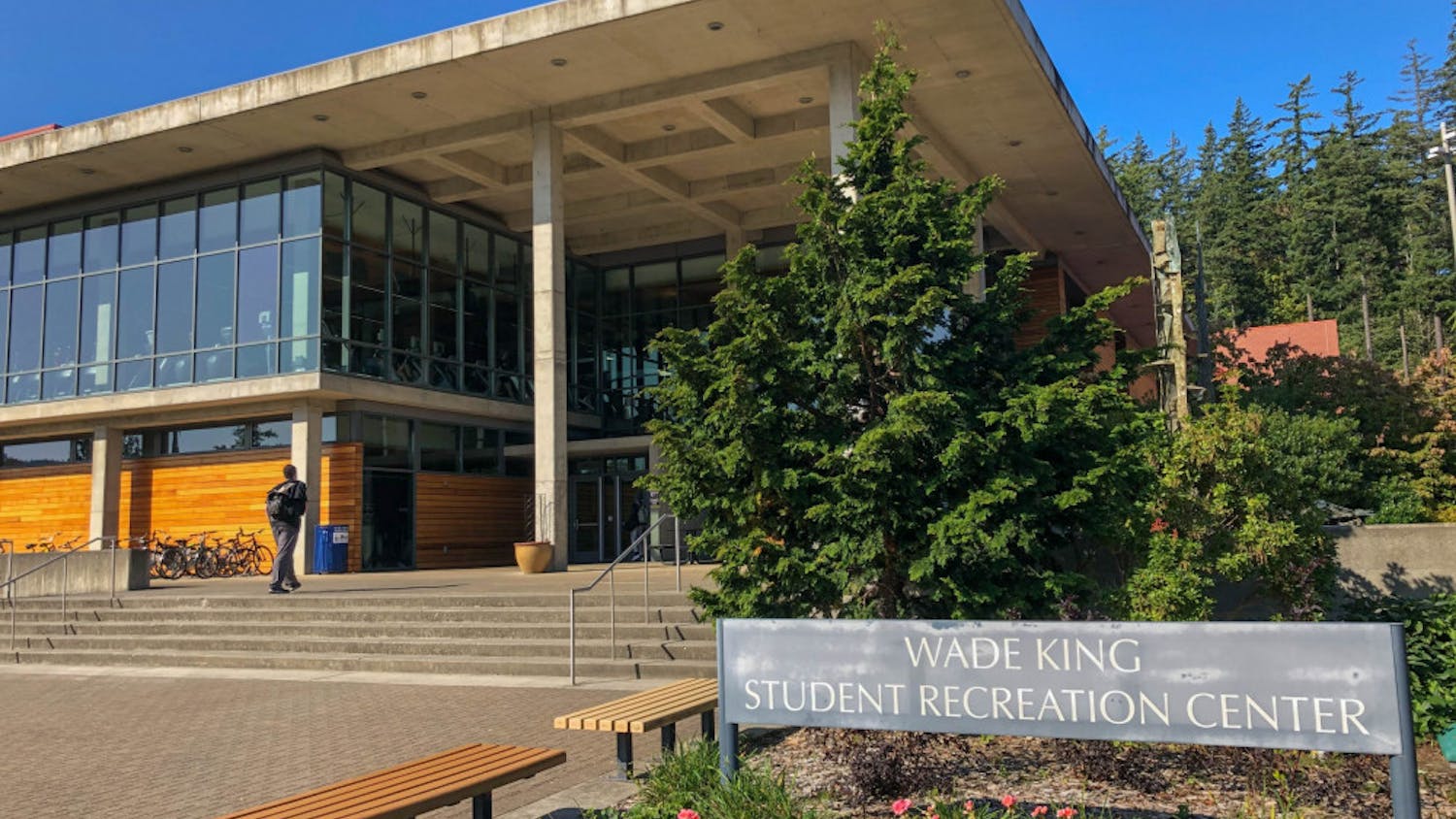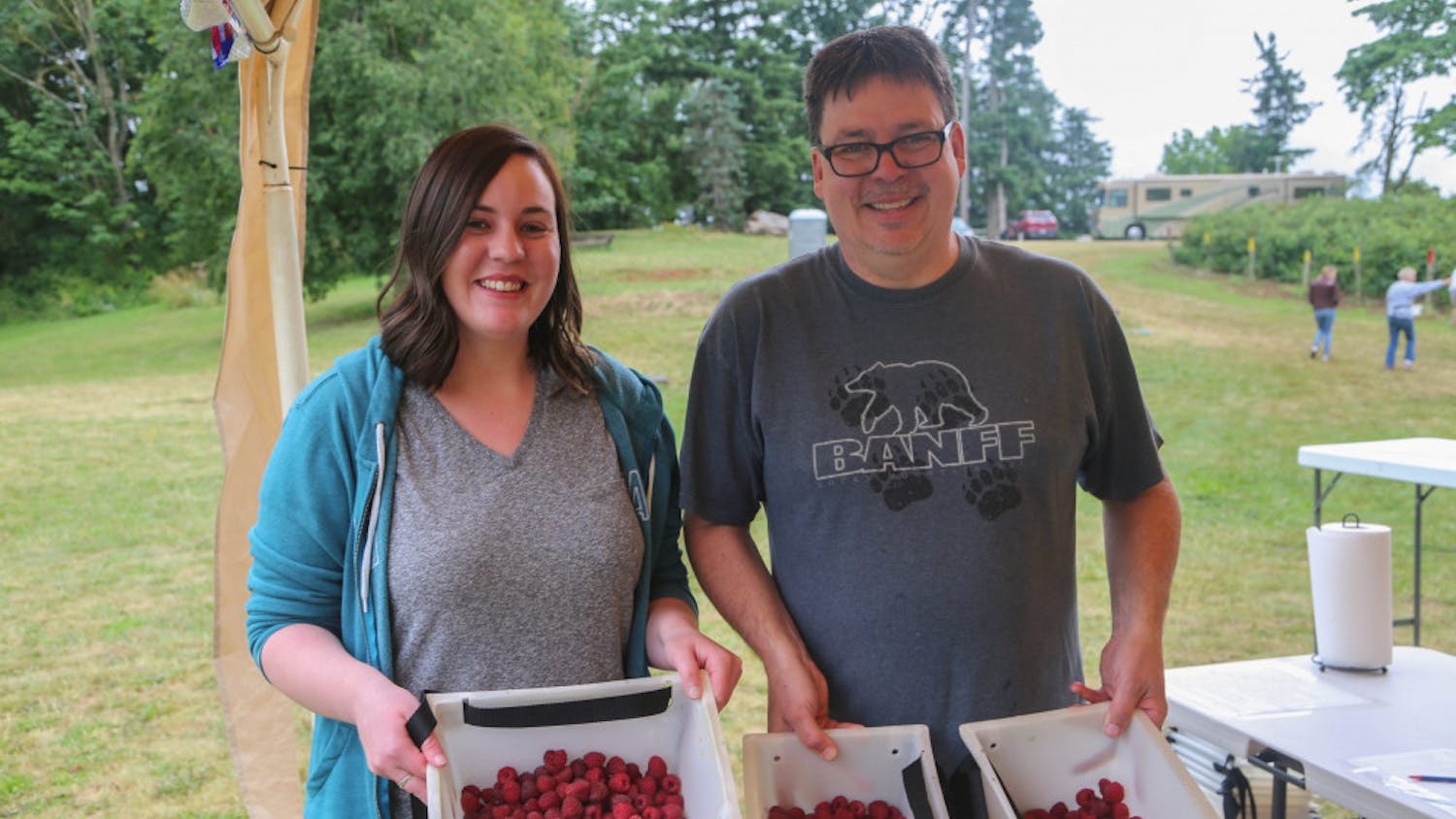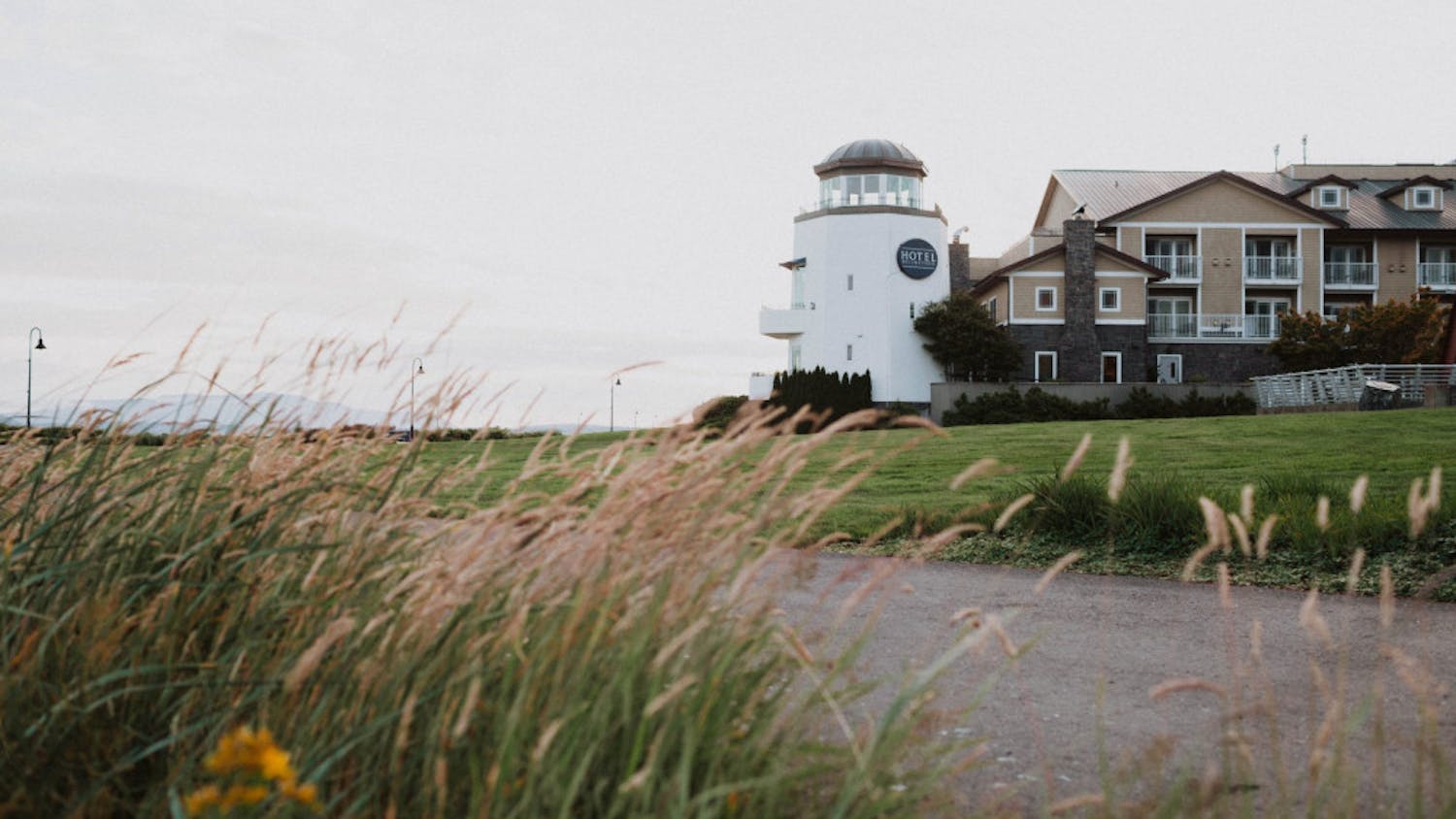Story
 The deeply layered and carefully carved plywood sculptures of Hannah Raper are clearly produced by someone who loves nature. There’s some that mimic the colorful hot springs found in Yellowstone, while others bring to mind the deep blues of ocean or outer space.
Raper was once a student studying environmental science at Western—someone who enjoyed leaning about land formations and different natural phenomena. But one concussion later, Raper was left unable to do the complex math and chemistry required for her major.
“I was left in this rut of ‘what do I do now?’ she said. “I was planning for my life. I sat down and realized it was always art, but I was too afraid to take that chance.”
People ask her what she wants to do after graduation as a now-art major, and her answer is “hopefully, art! Everyone’s dream as an artist is to make their art,” she said.
Her art is focused on appeasing two senses: both touch and sight.
“There’s something about being able to touch something that I’m obsessed with,” she said. In addition to creating interactive art, she doesn’t name her pieces. Raper wants a viewer to draw their own ideas and opinions about her work.
“If I come in with this pre-associated idea of what it needs to be, people are going to connect with my artwork much less,” she said. “And everyone connects with the environment in a different way. Unless you live in a cardboard box and you’ve never have been outside, you’re going to have a connection with nature.”
“Particularly people who live in the Pacific Northwest”, she said, “because we are surrounded with it.”
And Raper’s work isn’t just for the audience--her carving work has a way of calming her mind from any stress and anxiety that could weigh her down.
“For a long period of time, she said. “I was [compelled] to have everything perfect—I needed it to look a certain way. And one day I decided it was more stress than it was worth. And I started letting go and it has changed my complete outlook on life—allowing the medium guide me and take the direction it wants.”
She said that plywood is particularly temperamental to work with. “You’ll be doing something and suddenly a whole piece of wood will fly off—and that might have been your favorite piece of the entire work, and now it’s gone.”
One she started letting go, she began to realize art is more than just an end result--it’s about the process, she said.
“A lot of people are so attached to their artwork because they’ve spent so much time with it,” she said. “Whereas I feel, if I’ve properly resolved my piece, I’d be totally okay with it being gone, to pass it along to someone else.”
Inspiration
Hot springs, islands, coral reefs, salt evaporation ponds, Mariana Trench, the helix nebula—all of these naturally-occurring “color hotsports” have helped inspire Raper.
“I use Pinterest a lot,” she said. “It’s where I store all of my ideas, organize my thoughts and draw inspiration. You can pin something, pull down and then find similar images. Pinterest was showing me all of these images and I started recognized connections between different environmental motifs—whether that was in space or on earth or under the sea.”
She said her vocabulary from her environmental science classes has helped create and shape her work. Another influence on her artwork is topographic maps.
The deeply layered and carefully carved plywood sculptures of Hannah Raper are clearly produced by someone who loves nature. There’s some that mimic the colorful hot springs found in Yellowstone, while others bring to mind the deep blues of ocean or outer space.
Raper was once a student studying environmental science at Western—someone who enjoyed leaning about land formations and different natural phenomena. But one concussion later, Raper was left unable to do the complex math and chemistry required for her major.
“I was left in this rut of ‘what do I do now?’ she said. “I was planning for my life. I sat down and realized it was always art, but I was too afraid to take that chance.”
People ask her what she wants to do after graduation as a now-art major, and her answer is “hopefully, art! Everyone’s dream as an artist is to make their art,” she said.
Her art is focused on appeasing two senses: both touch and sight.
“There’s something about being able to touch something that I’m obsessed with,” she said. In addition to creating interactive art, she doesn’t name her pieces. Raper wants a viewer to draw their own ideas and opinions about her work.
“If I come in with this pre-associated idea of what it needs to be, people are going to connect with my artwork much less,” she said. “And everyone connects with the environment in a different way. Unless you live in a cardboard box and you’ve never have been outside, you’re going to have a connection with nature.”
“Particularly people who live in the Pacific Northwest”, she said, “because we are surrounded with it.”
And Raper’s work isn’t just for the audience--her carving work has a way of calming her mind from any stress and anxiety that could weigh her down.
“For a long period of time, she said. “I was [compelled] to have everything perfect—I needed it to look a certain way. And one day I decided it was more stress than it was worth. And I started letting go and it has changed my complete outlook on life—allowing the medium guide me and take the direction it wants.”
She said that plywood is particularly temperamental to work with. “You’ll be doing something and suddenly a whole piece of wood will fly off—and that might have been your favorite piece of the entire work, and now it’s gone.”
One she started letting go, she began to realize art is more than just an end result--it’s about the process, she said.
“A lot of people are so attached to their artwork because they’ve spent so much time with it,” she said. “Whereas I feel, if I’ve properly resolved my piece, I’d be totally okay with it being gone, to pass it along to someone else.”
Inspiration
Hot springs, islands, coral reefs, salt evaporation ponds, Mariana Trench, the helix nebula—all of these naturally-occurring “color hotsports” have helped inspire Raper.
“I use Pinterest a lot,” she said. “It’s where I store all of my ideas, organize my thoughts and draw inspiration. You can pin something, pull down and then find similar images. Pinterest was showing me all of these images and I started recognized connections between different environmental motifs—whether that was in space or on earth or under the sea.”
She said her vocabulary from her environmental science classes has helped create and shape her work. Another influence on her artwork is topographic maps. She’s also inspired by the Ragfinery material recycling store in Downtown Bellingham, and wants to eventually have her own shop, where she will spin her own wool.
“It would be great to do something that encompasses all forms of fiber work, she said, “not just fabric and yarn.”
Tools
To create the wood carvings, Raper uses a circular sander and a die grinder, which is similar to a dremel. She originally chose to use plywood, because it was an inexpensive material to create the large artworks required for one of her classes.
“They’re really heavy,” she said. “I definitely got a workout. When there were in their big pieces, I’d say they weighed over 50 pounds.”
She said plywood is make up of several layers and contains a random mix of hard and soft wood. “The Light sections are the hard wood and the darker is the soft,” Raper said.
She also adds oil to enhance the color of the wood, and paints the surface with acrylic paints. The unique qualities of plywood make it perfect for creating the lined works that look like topographical maps.
“As I grind though each layer, the glue is burning, creating this dark line. When I’m carving, it’s like I’m almost archeologically creating this new surface. I’m inspired by nature but it’s not a direct representation of [the landmarks]. I’m creating my own moveable piece of land—it becomes me, becomes mine. ”
Currently, Raper is producing 11 palm-sized artworks to stock the Art Drop vending machine in the art building. She’s recently started a new type of art, called needle felting.
This type of art produces soft objects, often figures in the form of animals, people or plants. She lays material on a foam block, then stabs the wool or felt with a triangle needle, causing the fabric to fluff up and take shape.
She’s creating small red mushrooms to sell. She hopes someone standing in front of the vending machine will see her felt mushrooms and say ‘oh I want to that—I want to touch it’ and then buy it to feel and hold it.
“I don’t know why mushrooms, Raper said. “I just really like mushrooms. There’s something really fantasy about mushrooms. Or maybe it’s a Bellingham thing, because a lot of people who go mushrooming.”
“But there’s this intensity of color that’s true to what you see in nature, she said. “You’d think it’s this chemically dyed material, but you can go outside and see mushrooms that are actually this color.”
She’s also inspired by the Ragfinery material recycling store in Downtown Bellingham, and wants to eventually have her own shop, where she will spin her own wool.
“It would be great to do something that encompasses all forms of fiber work, she said, “not just fabric and yarn.”
Tools
To create the wood carvings, Raper uses a circular sander and a die grinder, which is similar to a dremel. She originally chose to use plywood, because it was an inexpensive material to create the large artworks required for one of her classes.
“They’re really heavy,” she said. “I definitely got a workout. When there were in their big pieces, I’d say they weighed over 50 pounds.”
She said plywood is make up of several layers and contains a random mix of hard and soft wood. “The Light sections are the hard wood and the darker is the soft,” Raper said.
She also adds oil to enhance the color of the wood, and paints the surface with acrylic paints. The unique qualities of plywood make it perfect for creating the lined works that look like topographical maps.
“As I grind though each layer, the glue is burning, creating this dark line. When I’m carving, it’s like I’m almost archeologically creating this new surface. I’m inspired by nature but it’s not a direct representation of [the landmarks]. I’m creating my own moveable piece of land—it becomes me, becomes mine. ”
Currently, Raper is producing 11 palm-sized artworks to stock the Art Drop vending machine in the art building. She’s recently started a new type of art, called needle felting.
This type of art produces soft objects, often figures in the form of animals, people or plants. She lays material on a foam block, then stabs the wool or felt with a triangle needle, causing the fabric to fluff up and take shape.
She’s creating small red mushrooms to sell. She hopes someone standing in front of the vending machine will see her felt mushrooms and say ‘oh I want to that—I want to touch it’ and then buy it to feel and hold it.
“I don’t know why mushrooms, Raper said. “I just really like mushrooms. There’s something really fantasy about mushrooms. Or maybe it’s a Bellingham thing, because a lot of people who go mushrooming.”
“But there’s this intensity of color that’s true to what you see in nature, she said. “You’d think it’s this chemically dyed material, but you can go outside and see mushrooms that are actually this color.”
 She feels lucky that her class project for the Art Drop machine allows her to work on a small-scale project which she was already interested in outside of school
“Fortunately I found some that I really want to do and I can justify the time I’m spending on it because it’s for an assignment, she said. “That’s the best thing students can ever do in school—to match up what you want to do with what you have to do for class and be able to just enjoy it.
Next Steps
Raper plans to line her wood carvings with Velcro and eventually display them in the B-galley as an interactive exhibit. She said all her pieces will be on a table for visitors to touch and reorient. People have responded positively to her work in the past, Raper said.
“The biggest complement you can receive as an artist is ‘I’ve never seen that before’ or ‘that’s so different and unique’…I’m hoping to continue that with all of my work,” she said.
She feels lucky that her class project for the Art Drop machine allows her to work on a small-scale project which she was already interested in outside of school
“Fortunately I found some that I really want to do and I can justify the time I’m spending on it because it’s for an assignment, she said. “That’s the best thing students can ever do in school—to match up what you want to do with what you have to do for class and be able to just enjoy it.
Next Steps
Raper plans to line her wood carvings with Velcro and eventually display them in the B-galley as an interactive exhibit. She said all her pieces will be on a table for visitors to touch and reorient. People have responded positively to her work in the past, Raper said.
“The biggest complement you can receive as an artist is ‘I’ve never seen that before’ or ‘that’s so different and unique’…I’m hoping to continue that with all of my work,” she said.





